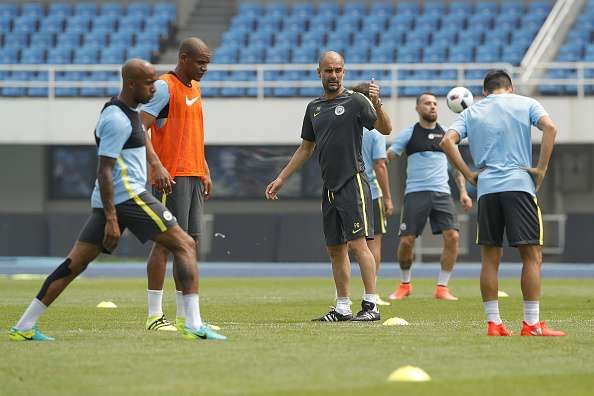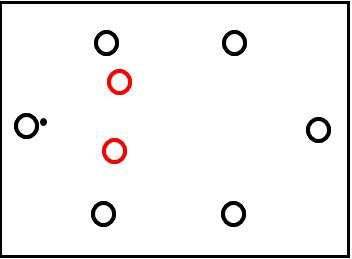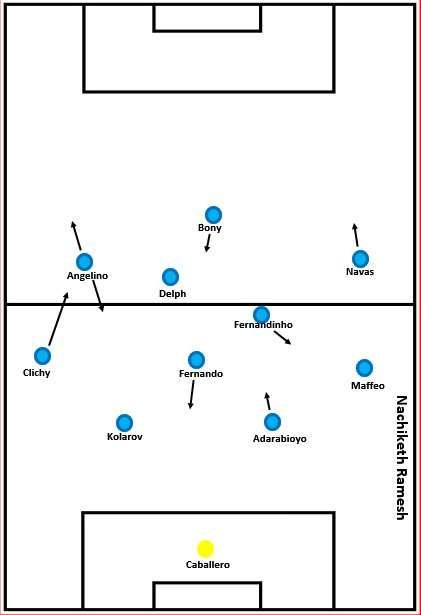
PEP TALK - 01: First Impression
PEP TALK is a new series on SportsKeeda and my blog (earlyshower.wordpress.com) concentrating on Pep Guardiola’s Manchester City team. Articles on pre-season activities, tactical analysis of the games in the regular season and general opinion pieces will be published under the title PEP TALK. Apart from the written pieces, video analysis will also be published on Youtube and Vimeo. So subscribe to these blogs and channels for regular updates on Guardiola's tenure at City.
Coming out of the cab and walking towards the people awaiting his arrival, Pep Guardiola, on the day of his unveiling as the new manager of Manchester City, jokingly said, “I need that right winger.” With all the hype surrounding him and expectations of millions of fans, Guardiola decided to bring in some humour to the scene and put the unwanted tension in the back of his head. After all, Guardiola was going to do a lot of interviews, pose for photos, meet a new bunch of people with whom he is going to work for at least the next three years and talk to the press.
Manchester City had arranged several interactive activities for Guardiola before the start of the EPL season, to feel at home and ensure that the process of adaptation was quick, as well as smooth. He was moving to a new country - different culture, language, climate and people - the four major factors that take the toll on people who move out of their comfort zone and into a new territory. City took care to ensure that their new manager and his team – which includes Domenec Torrent (Assistant manager), Manel Estiarte (Personal advisor to Guardiola), Lorenzo Buenaventura (Fitness coach), and Carles Planchart (Video analyst) – gelled with the people around them.
After settling in and taking charge, Guardiola had a few tasks to complete and road bumps to avoid. Guardiola must surely have watched and analysed videos of City’s games and training sessions during the month of June. With a clear picture of the changes to be brought in and when and how to make these changes in his mind, the Catalan manager must have had a plan. Say what? Two of his signings – Ilkay Gundogan and Nolito – were a key part of Guardiola’s blueprint for the upcoming season.
Borrell and Arteta
Guardiola decided to bring in Rodolfo Borrell, an ex-Liverpool coach, and Mikel Arteta to his coaching team. Borrell, after leaving Liverpool, worked with New York City FC and has experience of coaching at La Masia, and hence shares the same tactical and technical coaching attributes with Guardiola. Arteta, who is a La Masia product and has spent a few years of his career in Spain, is not new to possession-based playing style.
So, Borrell and Arteta will easily understand Guardiola’s vision for the team. The two also understand the English game and mentality since they have been living in England for several years and will help Guardiola in getting adjusted to the new country.
Training
The last three weeks of training have been entirely focused on the process of transferring all the ideas of Guardiola and his coaching team to the players during training. To achieve this there were specifically designed sessions to introduce new concepts to City’s playing squad.
Guardiola has already started to infuse his playing style of positional play, which demands a high level of technical ability from the players. In order to prepare them, the coaching team has been using precise training drills in each of the sessions.
The main intention of Guardiola’s sessions in the first three weeks have been to develop the players to play according to the principles or tools of positional play. Sessions have usually started (Note: in all the videos published and analysed) with simple passing drills as warm-up exercises to get the players ready for the subsequent drills by increasing their heartbeat at a gradual rate and making them less injury prone (training specific warm-up). This involved some short range passing and long range passes - aimed at switching the play from the overloaded region of the field to the under loaded region.
Rondos (6v2, 4v2, 6v3) follows after the warm-up exercises and are mainly used to improve first touch, passing under pressure, ball receiving under pressure, pressing with intensity and creativity. This also gives the players a sense of what they will be doing in the rest of the session. Rondos was part of Guardiola’s training session at Bayern Munich.
After rondos, some game related training is done. These are usually done to improve certain aspects of City’s game so that they can be fine-tuned as per what their new manager needs them to do on match day. These include explaining to the players positional details – where to position, how to and when to move, when to come near and when to fall back, the aims during the defensive transition, and bringing the ball out of the back.
On the first day, Guardiola was seen intervening with his players while they were being instructed on a specific aspect of the game – building an attack from the back while the defending team was pouring in numbers to press. Both attacking build-ups involving goalkeeper and high pressing to stifle such build-ups by opponents are needed for Guardiola’s team. With proper build-up from the back, numerical superiority can be achieved in the defensive third which allows the ball to be progressed to the middle third easily. On the other hand, high pressing in a coordinated manner can be helpful in winning the ball back close to the opponents’ goal.
Here’s a video analysis of the training methods of Guardiola at Manchester City that I prepared:
Some mini games such as 4v4+3 and 7v7 were practiced. 4v4+3 positional game helps the players in getting accustomed to playing in a high-pressing environment and thus changes the way they perceive footballing actions around them, improves decision making, as they learn from their errors and helps them execute the right actions. Such a training drill gives the players an edge over their opponents when playing in tight spaces during matches and helps in better ball circulation. 6v6+3 games are also much similar.
Here’s a video showing the 4v4+3 training drill of Guardiola:
If needed, some 7v7+1 mini-games are played with the extra player as the joker who joins the team in the possession phase. These games are played with high intensity and are usually 15 minutes long. Such training games help the players in executing whatever they learnt and playing as per the coaches’ demands. Guardiola can be seen stopping the game only a few times during the training games as he prefers to go with the flow, which is the right thing to do.
Although Manchester City hasn’t released the full video of any of its training sessions, there are some clips in which Guardiola can be shown training a certain detail to his defenders. A few isolated training drills with the ball were also practiced such as shooting drills. Fitness drills with some exercises using the ball can be seen in the video attached.
Some of the training sessions were conducted in Manchester while a few low-intensity ones (and mainly focusing on developing fitness) were conducted in China.
Match against Bayern Munich
Guardiola kicked off his managerial career with City when he took charge of the team against his old club Bayern Munich. In Munich, with memories fresh of the three good seasons as manager of Bayern, Guardiola received a warm welcome and many people from the club were eager to see him at Allianz Arena.
In the match, Guardiola started with a 4-1-4-1 formation. Willy Caballero was the goalkeeper, youngsters Pablo Maffeo, Tosin Adarabioyo, and Jose Angelino started along with Aleksandar Kolarov at the back, and Fernando played the pivot role. Brandon Barker played on the left wing while Jesus Navas featured on the right wing, Oleksandr Zinchenko and Fernandinho played in the central areas, and last season’s surprise find, Kelechi Iheanacho, started up front.
Manchester City’s start was not a bright one. The players, mainly the youngsters, took some time to get to grips with the game, as a result, Carlo Ancelotti’s Munich was in control in the early part of the game. Manchester City tried to play expansively while attacking. In the defensive phase, City high-pressed to stifle Bayern’s build-up play. Moments after losing the ball, in the defensive transitions, counter pressing was also evident.
City players were swarming around their Bayern opponents as soon as the ball was lost – mainly by trying to cover the passing lanes and forcing the opponents to give the ball away. But the pressing was not as effective as a well-drilled Guardiola team since the players were failing to sense the movements of the opposition and properly use their cover shadows.
As the game progressed Fernando started to drop into the space between the central defenders Kolarov and Adarabioyo, and brought the ball out of the back which in turn was moved to the attacking areas from the back. Since Bayern’s two forwards were pressing, Fernando’s presence also helped Guardiola’s team to achieve numerical superiority at the back.
From the back, with Fernando as Pivot. pic.twitter.com/QWrFKVB6Xb
— Nachiketh Ramesh (@NachikethRamesh) July 20, 2016
Whenever Bayern Munich’s attacks were getting thwarted and City were in need of an extra man at the back, Caballero was also getting involved in the play – which we have seen Manuel Neuer do in a ‘sweeper keeper’ role during Guardiola’s tenure at Bayern.
When Angelino, the left back was pushing up, Maffeo was moving inwards to form a back three with Adarabioyo and Kolarov. During such scenarios, Agenlino and Navas were occupying the wings, Adarabioyo, Fernando, Zinchenko and Iheanacho were occupying the central region and Fernandinho, Barker and the two remaining centre-backs were positioning in the half-spaces. The shape resembled a 3-1-4-2 formation. As Barker and Fernandinho were moving wider or changing their body orientations, direct passing routes from the central defenders to Iheanacho and Zinchenko were being created – and also multiple options to play layoff passes.
Navas and Agenlino wide; back 3 with Maffeo tucked in; Fnando pivot; Fdinho and Barker h-s, Ihea and Zinch central. pic.twitter.com/OS6jgBcTCt
— Nachiketh Ramesh (@NachikethRamesh) July 20, 2016
Having already exhibited attacking build-up from the back, high-press, counter pressing, usage of Caballero as an outfield option and some positional flexibility leading to different attacking shapes, Guardiola made a few changes in the second half and brought on a few key first team players – Fabian Delph, Gael Clichy, and Wilfried Bony. Due to Clichy taking up the left-back position, Angelino moved to left winger position where he was just as good as he was the left back role in the first half.
Angelino! #City pic.twitter.com/IAa7ZsDV2T
— Nachiketh Ramesh (@NachikethRamesh) July 20, 2016
With the changes, City assumed a more trademark 4-3-3 shape with Fernando as the No.6 and Delph and Fernandinho as the No. 8s. City were more dominant in the second half (although unfortunate to concede a goal).
Fernando was regularly seen swapping places with forward moving Adarabioyo and Angelino was moving to the central areas, allowing Clichy to overlap. Thus City displayed some dynamic positioning in the game as well!
Fernando drops to collect from Caballero against 2 Bayern forwards. Finds Clichy free. #city #bayern pic.twitter.com/Wrf0GhipBs
— Nachiketh Ramesh (@NachikethRamesh) July 20, 2016
Adarabioyo steps up from RCB, Fernando drops to fill the space. pic.twitter.com/J7ewWbGVuJ
— Nachiketh Ramesh (@NachikethRamesh) July 20, 2016
Overloading one wing and creating free space on the far side – one of the features of Guardiola’s playing style was also used to create space for the wingers a few times in the second half.
Fernandinho, in an overloaded space, finds Angelino running free. pic.twitter.com/fuv7xKzm5B
— Nachiketh Ramesh (@NachikethRamesh) July 20, 2016
Conclusion
Guardiola has assembled a good squad at City – both coaching and playing. However, since there a few positions that are yet to be filled, we can expect some transfer market activity. Gundogan and Nolito are some great signings and I am just as excited as you to see how they will be deployed by Guardiola.
Training has been going well and players have expressed their admiration towards their new manager and have started to like training sessions. The focus has been to get the squad ready to play the positional style of football. As of now, no injuries have been reported.
What goes on in training can be seen in an actual game and, in the game we saw that City have already started to emulate Guardiola’s style. The City team have shown the usage of overloads to create openings, width and depth in attack, involvement of the goalkeeper and pivot, and the midfield flexibility – which was so crucial at Bayern. Guardiola’s tactics at Bayern were able to create multiple shapes and confuse the opponents with his unpredictability. So, to conclude this first PEP TALK episode, the first impression has been very good.






